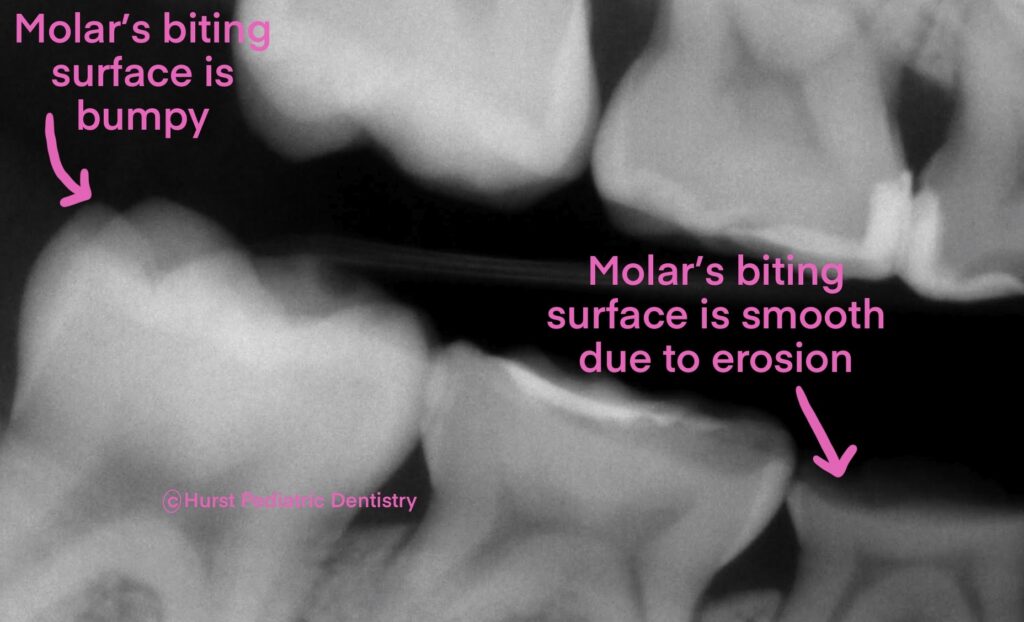What Is Dental Erosion?

Did you know that the hardest substance in your child’s body is the outer coating of his or her teeth? This outer coating, known as dental enamel, protects the sensitive, nerve-filled centers of your child’s teeth. But as hard as it is, your child’s dental enamel is not indestructible. Repeated exposure to acid, for example, can erode the enamel, potentially leading to cosmetic and/or functional concerns and tooth sensitivity.
In this article, we will discuss the following topics:
- What Is Dental Erosion?
- What Causes Erosion in Children’s Teeth?
- How Does Dental Erosion Affect Children’s Teeth?
- How Can My Child Prevent Tooth Erosion?
- How Is Dental Erosion Treated in Children?
What Is Dental Erosion?
Repeated exposure to acid can cause the hard surfaces on your child’s teeth to wear away. Teeth can be exposed to acids from a variety of sources. For example, cavity-causing bacteria inside your child’s mouth produce acid in response to certain foods and drinks your child consumes, which can eventually lead to cavities.
When the acids wearing away at your child’s teeth come from any source other than bacteria, we refer to the damage as dental erosion.
What Causes Erosion in Children’s Teeth?
As described above, dental erosion is caused by acids. The most common causes of repeated acid exposure in children (other than bacteria) are excessive consumption of acidic foods and drinks, GERD and bulimia.
- Acidic Foods and Drinks. Frequent consumption of acidic foods and beverages can lead to dental erosion in children. Some of the most common culprits include sodas, sports drinks, and energy drinks.
- GERD. Gastroesophageal reflux disease (“GERD”) is a condition that involves stomach acid flowing up into the esophagus (i.e., the tube that connects the throat to the stomach) and, in some cases, all the way up into the mouth. If stomach acid enters a child’s mouth on a repeated basis, it can lead to tooth erosion.
- Bulimia. Adolescents with bulimia who engage in self-induced vomiting may experience dental erosion. Vomiting exposes teeth to stomach acid; doing so on a frequent basis can cause excessive wear to the dental enamel.
Children who suffer from a dry mouth may be particularly susceptible to dental erosion. Saliva is the body’s natural defense mechanism against acid-related tooth wear. It dilutes and washes away acids that enter the mouth; it creates a protective coating over the surfaces of your child’s teeth that helps defend against acid erosion; and it helps to remineralize your child’s teeth (i.e., replace minerals in your child’s teeth that acids cause them to lose). As a result, when children have low levels of saliva in their mouths, regurgitated stomach acids and acidic foods/drinks can cause even greater damage to their teeth.
How Does Dental Erosion Affect Children’s Teeth?
Over the course of our lives, all of us will experience some natural wear and tear to our dental enamel. However, an excessive amount of wear and tear can lead to the following:
- Tooth Sensitivity. Underneath a tooth’s enamel is a porous surface called dentin. Dentin contains tiny tubes that lead to the sensitive, nerve-filled center of the tooth. When a tooth’s enamel erodes away to such an extent that dentin becomes exposed, hot, cold, sugary and/or acidic foods can stimulate the nerves inside the center of the tooth, leading to tooth pain or discomfort.
- Tooth Discoloration. Dental enamel gives kids’ teeth their white color. As enamel erodes away, the yellow dentin underneath will become more visible. In severe cases, there may be a large yellow spot (or spots) on a child’s tooth where all of the enamel has eroded away.
- Changes in Tooth Shape. As the enamel on a child’s tooth erodes away, you may notice changes to the shape of the tooth. To provide just a few examples:
- the chewing surfaces of your child’s molars, which are normally rough and bumpy, may become smooth as enamel is lost;
- you may notice “cupping” (i.e., dents or craters) in your child’s teeth;
- dental fillings your child has may appear raised up above the surface of your child’s tooth; or
- eroded teeth may begin to appear shorter than other teeth in your child’s mouth.

How Can My Child Prevent Tooth Erosion?
First and foremost, if you suspect your child might suffer from either GERD or bulimia, speak with your child’s pediatrician (or other applicable medical providers) to ensure your child gets all the help he or she may need.
That said, there are numerous steps that all children can take to help reduce their risk of dental erosion:
- Limit consumption of acidic foods and drinks, especially between meals. Some examples of acidic foods and drinks include sodas, energy drinks, sports drinks, lemonade, citrus juices, citrus fruits, sour candies and vinegar.
- Completely eliminating unhealthy sources of acid (like sodas, energy drinks and sour candies) from your child’s diet is ideal.
- Healthy acidic foods, such as fresh oranges and grapefruits, can be enjoyed along with a full meal (rather than between meals) to help reduce their erosive potential, since saliva production is stimulated during meals.
- If your child shows signs of dental erosion, your child’s pediatric dentist can review your child’s diet with you to help identify possible dietary causes and suggest modifications.
- Drink plenty of water to avoid dehydration and maintain adequate levels of saliva. (If your child suffers from chronic dry mouth, see our article on xerostomia for additional steps your child can take.)
- Drink milk or eat unsweetened yogurt or cheese immediately after consuming acidic foods or drinks to help neutralize the acids. If your child cannot have dairy, and is old enough to know how to spit out liquids, swishing with a baking soda rinse is an alternative option for neutralizing acids. You can make a baking soda rinse by mixing half a cup of water with half a teaspoon of baking soda. Give the solution to your child to swish and spit.
How Is Dental Erosion Treated in Children?
Unlike bones, which can heal after a break, your child’s dental enamel cannot regenerate. This means that the damage caused by dental erosion is permanent.
Fortunately, if your child is getting dental checkups regularly (i.e., at least once every six months), your child’s pediatric dentist will likely be able to spot erosion in its early stages, long before most children and parents would begin noticing problems. When dental erosion is spotted early, treatment can often be avoided by making lifestyle changes to prevent the erosion from worsening. Your child’s dentist can help you and your child identify possible causes of the erosion and suggest appropriate lifestyle modifications. Make sure to continue bringing your child in for regular checkups so that your child’s dentist can monitor the erosion.
If dental erosion is causing tooth sensitivity, your child’s dentist may suggest applying a fluoride varnish to help. This is a quick and painless procedure that has the added benefit of protecting your child’s teeth against cavities.
If the dental erosion is severe, your child’s dentist may need to use a white filling or a dental crown to restore the function and appearance of the eroded tooth.
Pediatric Dentistry in the Dallas-Fort Worth Area
Don’t let dental erosion ruin your child’s smile! Follow the prevention tips above and bring your child in for regular dental checkups so that any erosion can be spotted early. Hurst Pediatric Dentistry’s board-certified pediatric dentist is highly experienced at identifying dental erosion in all its stages, providing treatment as needed, and educating patients and parents on how to minimize future damage. Call us at 817-510-6400 or fill out our online form to request an appointment for your child.
Hurst Pediatric Dentistry is located in Hurst, Texas, and is proud to serve pediatric patients from Hurst, Euless, Bedford, Colleyville, Southlake, Grapevine, Keller, Fort Worth, Arlington, Irving, and the surrounding area.
This article is intended to provide general information about oral health topics. It should not be used to diagnose or treat any disease or as a substitute for the advice of a healthcare professional who is fully aware of and familiar with the specifics of your case. Always seek the advice of your dentist or other qualified healthcare provider with any questions you may have regarding a medical condition or treatment.
MEDICALLY REVIEWED BY:
Dr. Jin Lin

Dr. Jin Lin is a board-certified pediatric dentist with a passion for helping children achieve healthier, more beautiful smiles. He earned his Bachelor of Science degree from Cornell University and his Doctor of Dental Medicine (D.M.D.) degree from the Harvard School of Dental Medicine. After graduating cum laude from dental school, he completed his post-doctoral pediatric dentistry training at Boston Children’s Hospital and the Harvard School of Dental Medicine, where he served as chief resident and worked with children with a wide variety of special medical and dental needs, including children with rare syndromes.

